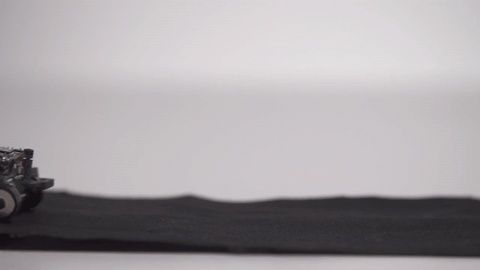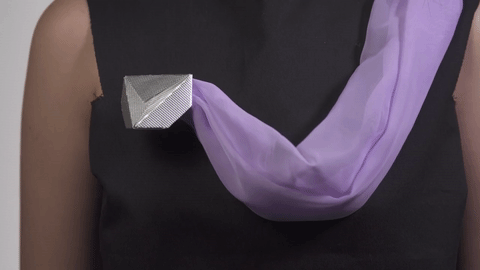


Project Kino was inspired by ‘living jewelry,’ large bedazzled beetles and other insects worn as decoration in different parts of the world. The MIT Media lab version is much more humane, however, using palm-sized robots that cling onto clothing with magnets. The team has been demoing the work for about a year now and has come up with a wide range of functions for the little wheeled robots.

For now, most of the robots’ tasks are decorative. The project’s name derives from the word “kinetic,” referring to the their movement as they reconfigure into different patterns, keeping the clothing designs ever changing. On other surfaces, the robots can etch visible designs in the clothing, as they move around.
The lab is also exploring some interesting non-design functions. In a more finalized version, the robots could be modular, so users can swap different sensors and other features in and out, based on functionality. On a raincoat, for example, temperature sensors could trigger the robots to pull the hood’s strings down

Another module could double as a phone receiving, moving the ‘bot up to the wearer’s mouth when a call comes in. In yet another scenario, the robot moves toward the wrist to deliver haptic feedback when a notification comes in.
“We’re thinking of wearables as a personal assistant,” team member Cindy Hsin-Liu Kao told TechCrunch. “We think in the future, when they can have a brain of their own, they can learn your habits, learn your professional style, and when they get smaller, they can blend into the things you wear.”

Size is the key constraint at the moment — the robots are too big to be practical. And in spite of their large size, the battery life is still another limitation in the demo versions. The robots the team is currently showing off only last around 45 minutes on a charge. They’re currently working on some fixes, however, including wireless charging embedded into clothing. In that scenario, the robots simply ride over the charging pad for a fill-up and then return to their regular spot once recharged.
The team first published a paper detailing early versions of the robots last year. It has since teamed with designers to highlight some of the applications because, according to Hsin-Liu Kao, “a lot of people saw them as really creepy.”
Source: Tech Crunch, Project Kino
